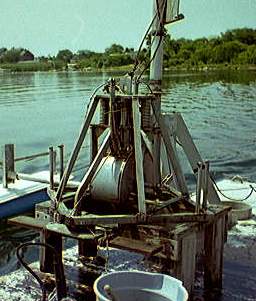|
Grain Size
After acidification and treatment with hydrogen
peroxide, the samples were sieved to separate the
sand (>63 µm) fraction. The remaining
fractions were measured for silt and clay on an Elzone
180 XY Particle Size Analyzer. All data are reported
as % of the total sample.
Organic Carbon
Salt Ponds:
Total organic
carbon (TOC) measurements were done by loss-on-ignition
with a 12 hour dewatering step (110ºC) and a
one hour ignition step (550ºC). A factor of 0.44
was used to convert organic matter to organic carbon.
A representative subset of samples was measured on a carbon-hydrogen-nitrogen
(CHN) analyzer for verification. Samples with >70%
sand were excluded from the analysis.
Narragansett Bay and Massachusetts Rivers:
Total carbon
was measured by CHN analyzer.
Trace Metals
Extraction
Total digestion technique:
This technique was used for trace
metal determination for all of the Salt Ponds samples,
and for the Narragansett Bay Follow-up study (including
Massachsuetts river sites). 0.2g of freeze
dried sediment was digested with concentrated hydrochloric, nitric,
and hydrofluoric acids in a heated sonicator bath. It was neutralized
after 48 hours with boric acid, and brought to volume with
deionized water.
Partial digestion technique:
This method was used for trace metal
determination for all of the Narragansett Bay Project
dataset, as well as a subset of the Narragansett Bay Follow-up
dataset. 2N nitric acid was added to 2g of freeze dried
sediment, and samples were placed in a constant temperature
water bath at 50ºC for 50 hours. After the digestion
was complete, samples were centrifuged at 2500 RPM for 10 minutes.
The supernatant was decanted and stored until analysis.
Analysis
Salt Ponds:
The samples
were analyzed for Cu and Pb using a Perkin Elmer 4100
ZL graphite furnace atomic absorption spectrometer with
Zeeman correction. The samples were analyzed for
Hg using an automated mercury analyzer.
Narragansett Bay and Massachusetts Rivers:
Pb was analyzed
with a Perkin Elmer 4100 ZL graphite furnace AA with
Zeeman background correction. Copper was analyzed
with an ARL model 3410 Inductively Coupled Argon Plasma
ICP. Samples were analyzed for mercury using an automated
mercury analyzer.
|






